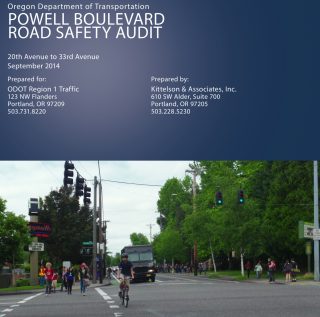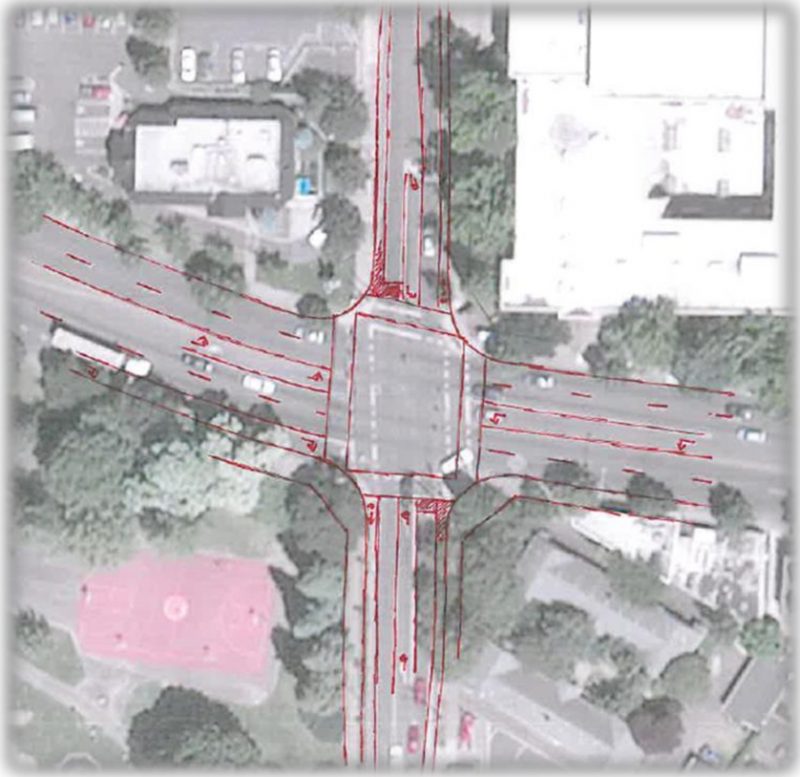
– download PDF –
The Oregon Department of Transportation is so convinced that the bike lanes on Southeast 26th Avenue are dangerous for bicycle riders that they’ve ordered the City of Portland to remove them as soon as possible.
Inexplicably, and despite evidence showing the bike lanes (even at a paltry three-feet wide) make the street safer, ODOT has cited no evidence or best practice standards for their decision. The only rationale offered so far is a concern that the intersection of 26th and Powell is too dangerous for bike riders and a new crossing two blocks east is much safer.
Everyone agrees the new signal and median at SE 28th (part of the new 20s Bikeway) is indeed much safer. But it’s up a hill and two blocks away. And since when is a safer crossing on one street, reason for the removal of bike infrastructure from another?
“ODOT’s reasons are a mystery to us,” a Portland Bureau of Transportation staffer told me recently.
Now there’s a new (to us) piece to the puzzle: A “road safety audit” report prepared for ODOT by Kittelson & Associates, Inc. in 2014. The audit (PDF) focused specifically on Powell between 20th and 33rd Avenue — a section with a crash rate over twice as high as the statewide average for similar roads. The stated purpose of the audit was to, “identify potential issues contributing to crashes and suggest treatments for addressing those issues.”
26th Avenue was one of the intersections that the team of engineers and planners analyzed. Of the 10 specific intersections assessed in the audit, 26th was one of five placed in “Category III”. That’s the highest of the three categories for issues defined as having, “potentially the greatest risk compared to the other observed issues; they are associated with higher exposure, probability, and/or consequence than other issues.”
Advertisement
The audit makes is clear that the Powell and 26th intersection needs help. And it’s especially dangerous for bicycle riders. According to the audit, there were five reported crashes involving a bicycle rider in this section of 26th between 2008 and 2013 — and four of them happened at 26th. “The majority of bike crashes involved bicyclists traveling through the intersection (north or south) and a vehicle making a turning movement,” states the audit.
Of the many recommendations, the report urged ODOT to improve safety at 26th by addressing vehicle turning movements. They suggested prohibiting right turns on red, adjusting signal timing so that drivers don’t get impatient, and they even recommended the use of “leading pedestrian intervals” (LPIs, where the “walk” signal comes on before the main signal turns green). The audit also recommended an “expanded pedestrian landing area” on all the corners to “discourage pedestrians (e.g., students at Cleveland High School) from standing in the roadway.”
When it came to the now infamous bike lanes on 26th, the audit recommended either tearing them out or — surprisingly — widening them.

As part of “system-wide suggestions for lack of protection for bike crossings,” the audit recommended, “installing bike lanes on cross-streets heavily traveled by bicyclists (21st Avenue, 26th Avenue (wider)…”
Here’s more:
“Consider the following two options to accommodate bikes crossing Powell Boulevard: Widen both sides by removing the landscape strip and moving the bus stop to accommodate wider bike lanes on both sides.”
Of course, the audit also recommended removing the bike lanes and replacing them with a new crossing further east on Powell. The latter part of that recommendation has occurred. Thankfully, the former hasn’t. At least not yet.
When asked to comment on Kittelson’s recommendation to widen the bike lanes, ODOT spokesperson Don Hamilton told me today that, “Nothing has changed since our previous conversations.”
As for the removal of the bike lanes? “Additional conversations are under way,” he said.
Hamilton’s reply jibes with what I’ve heard from another source close to the “additional conversations.” I’ll share more when I hear it, but for now it appears that the bike lanes just might survive. Whether or not they’ll ever be widened however, remains to be seen.
For a comprehensive look at how Powell is dangerous by design, check out the audit for yourself.
— Jonathan Maus: (503) 706-8804, @jonathan_maus on Twitter and jonathan@bikeportland.org
Never miss a story. Sign-up for the daily BP Headlines email.
BikePortland needs your support.



